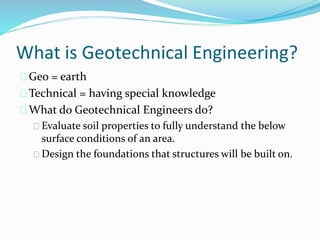The smart Trick of Geotheta That Nobody is Talking About
The smart Trick of Geotheta That Nobody is Talking About
Blog Article
The Main Principles Of Geotheta
Table of ContentsThe Ultimate Guide To GeothetaGeotheta Things To Know Before You Get ThisGetting The Geotheta To WorkAn Unbiased View of GeothetaNot known Incorrect Statements About Geotheta

They perform site examinations, accumulate examples, carry out research laboratory tests, and examine data to assess the suitability of the ground for construction projects - Consulting Engineer. Based upon their findings, geotechnical designers offer suggestions for structure design, incline security, keeping frameworks, and reduction of geotechnical risks. They collaborate with various other experts, such as engineers, architectural engineers, and construction teams, to guarantee that geotechnical factors to consider are integrated right into the overall project layout and application
By examining the habits and properties of soil and rock, they can recognize prospective geotechnical dangers such as landslides, soil negotiation, or incline instability. Their knowledge aids avoid failings or mishaps that might jeopardize lives and residential or commercial property. Below are some comprehensive duties and responsibilities of a geotechnical designer: Site Examination: Geotechnical engineers conduct site investigations to collect data on subsurface problems.
They analyze the information to recognize the buildings and actions of the dirt and rock, including their toughness, permeability, compaction qualities, and groundwater problems. Geotechnical Evaluation and Style: Geotechnical engineers evaluate the data gathered throughout website examinations to assess the security and suitability of the site for building jobs. They execute geotechnical estimations and modeling to evaluate elements such as bearing ability, settlement, incline security, lateral planet stress, and groundwater flow.
More About Geotheta
Foundation Design: Geotechnical engineers play a crucial function in making foundations that can safely support the designated framework. They assess the soil conditions and tons requirements to determine the ideal structure type, such as superficial foundations (e.g., grounds), deep structures (e.g (https://www.mixcloud.com/geotheta/)., piles), or specialized strategies like soil enhancement. They think about variables such as settlement limits, birthing capacity, and soil-structure communication to create optimum structure layouts
They assess building strategies, display website activities, and conduct field inspections to verify that the design recommendations are complied with. If unanticipated geotechnical problems arise, they analyze the situation and supply recommendations for remediation or changes to the style. Risk Analysis and Reduction: Geotechnical engineers examine geotechnical threats and dangers connected with the job site, such as landslides, liquefaction, or dirt erosion.

Partnership and Communication: Geotechnical engineers function carefully with other professionals involved in a project, such as designers, structural designers, and building and construction groups. Effective interaction and collaboration are important to incorporate geotechnical factors to consider right into the total job layout and building and construction process. Geotechnical engineers provide technical proficiency, answer inquiries, and ensure that geotechnical requirements are met.
4 Easy Facts About Geotheta Explained
Here are some kinds of geotechnical engineers: Structure Engineer: Structure engineers concentrate on making and analyzing foundations for structures. They assess the soil problems, tons demands, and site characteristics to figure out one of the most appropriate structure type and layout, such as shallow structures, deep foundations, or specialized techniques like heap foundations.
They assess the variables affecting incline security, such as dirt residential or commercial properties, groundwater conditions, and slope geometry, and establish techniques to stop incline failures and minimize dangers. Earthquake Designer: Quake engineers specialize in analyzing and making structures to stand up to seismic pressures. They evaluate the seismic threat of a website, evaluate dirt liquefaction possibility, and create seismic design criteria to ensure the safety and durability of structures during quakes.
They execute field screening, collect samples, and examine the collected data to identify the dirt residential properties, geologic formations, and groundwater conditions at a website. Geotechnical Instrumentation Designer: Geotechnical instrumentation engineers concentrate on tracking and gauging the habits of soil, rock, and frameworks. They set up and maintain instrumentation systems that check elements such as soil negotiation, groundwater levels, slope movements, and architectural variations to analyze performance and offer very early warnings of possible problems.
Some Ideas on Geotheta You Need To Know
They perform tests such as triaxial tests, loan consolidation tests, straight shear examinations, and permeability examinations to gather data for geotechnical evaluation and design. Geosynthetics Designer: Geosynthetics designers focus on the design and application of geosynthetic products, such as geotextiles, geogrids, and geomembranes. They make use of these products to enhance dirt stability, reinforce inclines, supply drain options, and control disintegration.
They often tend to be investigative people, which means they're intellectual, reflective, and curious. They are curious, methodical, reasonable, analytical, and rational. Some of them are additionally social, suggesting they're kind, charitable, participating, person, caring, useful, compassionate, tactful, and pleasant - Tailings Engineer.
In the office setting, geotechnical engineers utilize specialized software application devices to carry out computations, develop layouts, and examine data. They prepare reports, testimonial project specifications, communicate with clients and employee, and coordinate task tasks. The workplace setup supplies a helpful setting for research, analysis, and collaboration with other professionals associated with the project.
Geotheta - The Facts
They regularly check out job websites to conduct site investigations, analyze geotechnical problems, and gather data for analysis. These visits entail traveling to different locations, sometimes in remote or difficult surfaces. Geotechnical designers may execute dirt sampling, conduct tests, and display building and construction tasks to ensure that the geotechnical aspects of the project are being executed properly.
Geotechnical designers likewise function in specialized geotechnical research laboratories. Geotechnical laboratory engineers function thoroughly in these settings, dealing with testing tools, operating instruments, and tape-recording data.
Report this page